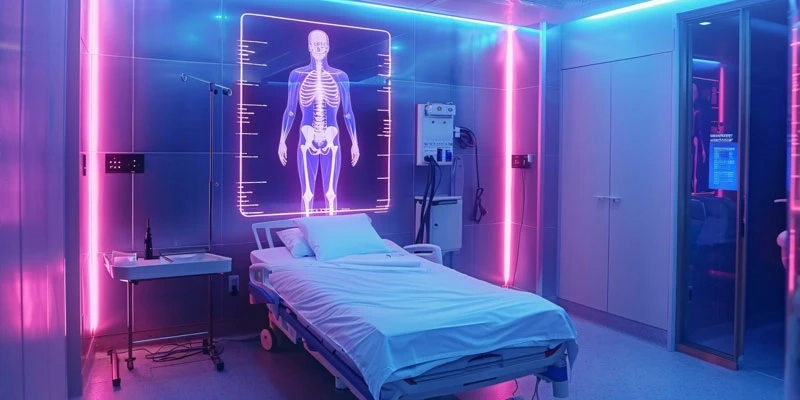
The Challenge: Inefficient Asset Management in Hospitals
Picture a busy hospital floor during peak hours. A nurse urgently needs an infusion pump for a critically ill patient, but it’s nowhere to be found. Staff members scour storage rooms and neighboring departments in vain, only to discover later that the pump was sitting unused in another hospital wing. Meanwhile, another department places an unnecessary order for new equipment, assuming their assets are missing. This chaos not only wastes precious time but also inflates operational costs and delays critical patient care.
Hospitals rely on a wide array of assets, such as infusion pumps, defibrillators, wheelchairs, and monitors, to provide timely and effective care. However, traditional asset management methods often fall short. Inefficiencies such as misplaced equipment, redundant purchases, and underutilized resources create significant challenges:
- Wasted Staff Time: Nurses and technicians spend countless hours searching for unavailable or misplaced equipment, diverting their focus from patient care and reducing productivity.
- Decreased Asset Utilization: Poor tracking leads to some assets being overused and others sitting idle, disrupting workflows and resource allocation.
- Unnecessary Purchases: Without accurate tracking, hospitals often replace equipment prematurely or unnecessarily, straining already tight budgets.
- Increased Costs: Irregular maintenance schedules result in asset downtime, higher repair costs, and shortened lifespans, all of which add to operational expenses.
These inefficiencies collectively burden hospitals with financial strain, operational disruptions, and compromised patient outcomes.
The Solution: Real-Time Location Systems (RTLS) for Asset Tracking
To address these challenges, hospitals are turning to Real-Time Location Systems (RTLS)—a transformative technology that brings order to the chaos of asset management. RTLS leverages IoT-powered sensors and advanced tracking tools to provide real-time visibility into the location, movement, and usage of assets. Here’s how it tackles key issues:
1. Saving Valuable Staff Time
- RTLS eliminates the need for frantic equipment searches, enabling healthcare staff to locate critical assets instantly. Whether it’s an infusion pump, a defibrillator, or a wheelchair, assets can be found quickly and efficiently:
- Quick Asset Retrieval: Staff can focus on patient care rather than wasting time looking for misplaced devices.
- Enhanced Workflow Efficiency: By reducing the time spent on logistical tasks, healthcare professionals can dedicate more attention to critical responsibilities, improving both productivity and morale.
In high-pressure environments, where every second matters, these capabilities can significantly enhance patient care.
2. Optimizing Asset Utilization
RTLS provides data-driven insights that help hospitals maximize the use of their resources:
- Tracking Usage Patterns: RTLS captures data on how and where equipment is used, helping administrators identify underutilized assets and reallocate them effectively.
- Preventing Redundant Purchases: Clear visibility into inventory prevents unnecessary equipment orders, saving money and reducing waste.
- Balanced Resource Allocation: Hospitals can redistribute equipment to areas of high demand, ensuring every asset contributes to patient care efficiently.
By leveraging RTLS insights, hospitals can make smarter decisions, reduce costs, and improve resource availability.
3. Streamlining Maintenance with CMMS Integration
- RTLS goes beyond tracking by integrating with Computerized Maintenance Management Systems (CMMS) to improve asset maintenance and reduce downtime:
- Automated Scheduling: Maintenance tasks are scheduled automatically based on real-time data, ensuring timely calibration and repairs without disrupting operations.
- Real-Time Monitoring: Technicians receive instant notifications about maintenance needs and asset locations, speeding up response times and minimizing workflow interruptions.
- Extended Asset Lifespan: Regular maintenance keeps equipment in optimal condition, reducing emergency repairs and maximizing the lifespan of expensive assets.
This integration ensures hospitals can rely on their assets to deliver uninterrupted, high-quality care.
The Results: Transforming Hospital Operations with RTLS
Hospitals that have adopted RTLS solutions report remarkable results:
- 94% Reduction in Search Times: Staff can locate critical equipment almost instantly, enhancing emergency response capabilities.
- 90% Reduction in Asset Misplacement: Real-time tracking virtually eliminates the need for unnecessary replacements, saving both time and money.
- Significant Cost Savings: Efficient asset utilization and reduced downtime result in lower operational costs.
With RTLS, hospitals are not just solving logistical challenges—they’re creating environments where patients receive timely, effective care, and healthcare staff can work at their full potential.
A Smarter Future for Healthcare
RTLS solutions empower hospitals to take control of their assets, optimize workflows, and deliver superior patient outcomes. By integrating IoT technology, real-time tracking, and AI-driven insights, hospitals can overcome inefficiencies, save costs, and focus on what matters most: providing exceptional care.
